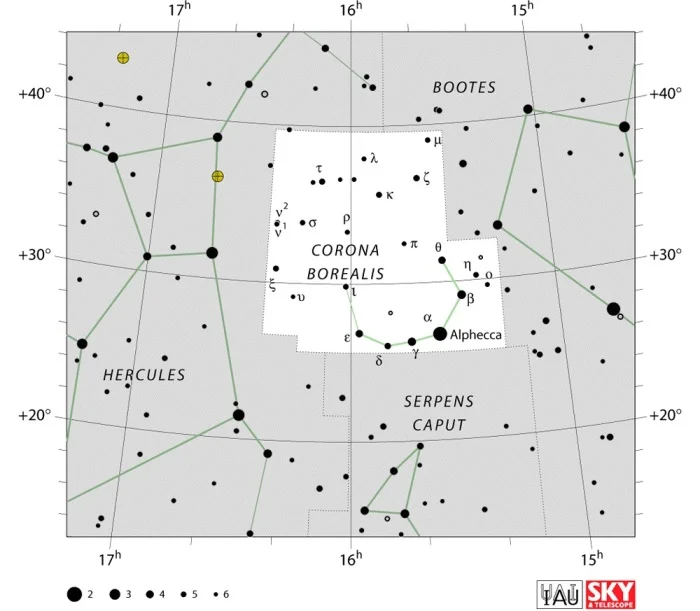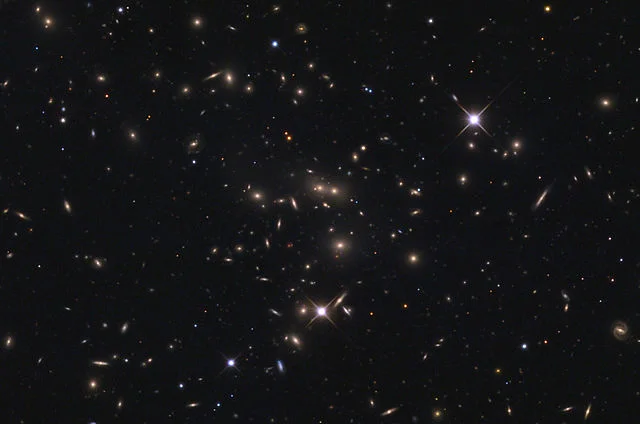Corona Borealis is a small but recognizable constellation in the northern sky. Its name means “the northern crown” in Latin.
The constellation has only four stars brighter than magnitude 3.00. It was first catalogued by the Greek astronomer Ptolemy in the 2nd century. At the time, it was known simply as Corona. The Greeks saw the constellation representing the southern crown, Corona Australis, as a wreath.
Corona Borealis lies between the constellations Boötes and Hercules and represents the crown of Ariadne, daughter of King Minos in Greek mythology, who helped the hero Theseus defeat the Minotaur and find his way out of the labyrinth in which the creature lived. In Celtic mythology, Corona Borealis is known as Caer Arianrhod, or the Castle of Arianrhod, the place where the mythical Lady Arianrhod lived.
Corona Borealis contains the famous Blaze Star (T Coronae Borealis), a recurrent nova, and the Fade-Out Star (R Coronae Borealis), but does not have any bright deep sky objects. The Corona Borealis Galaxy Cluster (Abell 2065) does not contain any galaxies brighter than 16th magnitude.
Facts, location and map
Corona Borealis is the 73rd constellation in size, occupying an area of 179 square degrees. It lies in the third quadrant of the northern hemisphere (NQ3) and can be seen at latitudes between +90° and -50°. The neighboring constellations are Boötes, Hercules, and Serpens Caput.
The constellation name Corona Borealis is pronounced /koʊˈroʊnə ˌbɔːriˈælɪs, -ˈeɪlɪs/. In English, the constellation is known as the Northern Crown. The genitive form of Corona Borealis, used in star names, is Coronae Borealis (pronunciation: /koʊˈroʊniː bɔːriˈælɪs/). The three-letter abbreviation, adopted by the International Astronomical Union (IAU) in 1922, is CrB.
Corona Borealis belongs to the Ursa Major family of constellations, along with Coma Berenices, Boötes, Camelopardalis, Canes Venatici, Draco, Leo Minor, Lynx, Ursa Major and Ursa Minor.
Corona Borealis has four stars with known planets and contains no Messier objects. The brightest star in the constellation is Alphecca (or Gemma, Alpha Coronae Borealis). There are no meteor showers associated with the constellation.
Corona Borealis contains four named stars. The star names approved by the International Astronomical Union (IAU) are Alphecca, Kamui, Moldoveanu, and Nusakan.

Corona Borealis constellation map by IAU and Sky&Telescope magazine
Myth
Corona Borealis is associated with the myth of Princess Ariadne of Crete, most famous for her part in helping the Greek hero Theseus defeat the Minotaur, the creature with a human body and head of a bull that lived in a labyrinth designed by Daedalus. In the myth, Ariadne married the god Dionysus. The circlet of stars in the constellation Corona Borealis represents the crown made by the god Hephaestus that she wore on her wedding day.
The Minotaur was in fact Ariadne’s half-brother: according to the legend, her mother Pasiphae gave birth to the creature after copulating with one of King Minos’ bulls. The king had the Minotaur locked inside the labyrinth to hide the family secret. The labyrinth was designed in such a way that no one, not even the Minotaur, could find a way out.
When Theseus came to Crete, he was chosen to be one of the people put into the labyrinth for the Minotaur to find and eat. Ariadne fell in love with Theseus and, following Daedalus’ advice, gave him a ball of thread to take with him into the labyrinth if he promised to take her with him once he escaped. Theseus agreed. Once he defeated the Minotaur with his bare hands, the hero followed the trail of the thread and found his way out of the labyrinth.
Ariadne and Theseus sailed off together shortly thereafter, but he soon abandoned her on the island of Naxos. The god Dionysus found the princess weeping, fell in love, and the two were soon married. Ariadne wore a crown made by Hephaestus at the wedding and, once the ceremony was over, she tossed it into the sky, where the jewels turned into stars and the crown became the constellation Corona Borealis. The brightest star in the constellation, Gemma, got its name from the Latin word for “jewel.”
The Arabs know the constellation as “the poor people’s bowl” or Alphecca, which means “broken up.” The name Alphecca was later given to the constellation’s brightest star, Alpha Coronae Borealis.
The Cheyenne called the constellation the Camp Circle because its shape was similar to the way they arranged their camps, in a semi-circle.
In Australia, Corona Borealis is known as Woomera, the Boomerang, and the Welsh associate it with the castle of Lady Arianrhod, the Welsh goddess who gave birth to two sons through magical means.
Corona Borealis stars
Alphecca (Gemma) – α Coronae Borealis (Alpha Coronae Borealis)
Alpha Coronae Borealis is the brightest of the seven stars that make up Ariadne’s crown. It is an eclipsing binary star classified as an EA variable, with a period of 17.36 days. The star has an apparent magnitude that varies between 2.21 and 2.32. It is approximately 75 light years distant.
The primary component in the Alpha Coronae Borealis system is a white, class A0V main sequence star emitting an excess of infrared radiation and believed to have a large disc of dust and material around it, and possibly a planetary or proto-planetary system in its orbit.
The companion is a young, yellow main sequence star, belonging to the spectral class G5.
The star system is believed to be a member of the Ursa Major Moving Group, a group of stars that includes some of the brightest stars in the constellation Ursa Major that share a common motion through space.
Alpha Coronae Borealis is known by several names: Alphecca (which loosely means “the bright one of the broken ring” in Arabic), Gemma (“jewel” in Latin), Asteroth, and Gnosia (short for “Gnosia stella coronae,” or “the star of the crown of Knossos” in Latin).
Nusakan – β Coronae Borealis (Beta Coronae Borealis)
Beta Coronae Borealis is a spectroscopic binary, with a period of 10.5 years. It is an Alpha-2 Canum Venaticorum (ACV) type variable star with a period of 18.487 days and a magnitude varying between 3.65 and 3.72. Alpha-2 Canum Venaticorum variables are main sequence stars of spectral class B8p to A7p that are chemically peculiar and have strong magnetic fields and strong strontium, silicon or chromium spectral lines. They are named after a star in the Cor Caroli system in the constellation Canes Venatici.
Beta Coronae Borealis is 114 light years distant from the solar system. It is the second brightest star in Corona Borealis. Its traditional name, Nusakan, comes from the Arabic an-nasaqan which means “the (two) series.”
γ Coronae Borealis (Gamma Coronae Borealis, Struve 1967)
Gamma Coronae Borealis is a close binary star with an orbit of 91 years. The two components in the system are only 0.2’’ apart.
Gamma Coronae Borealis is classified as a Delta Scuti variable (or a so-called dwarf Cepheid), a star showing variations in luminosity as a result of both radial and non-radial pulsations of its surface. It belongs to the spectral class A0. The star’s apparent magnitude varies from 3.80 to 3.86 with a period of 0.03 days (43 minutes and 12 seconds).
ζ Coronae Borealis (Zeta Coronae Borealis)
Zeta Coronae Borealis is another double star in the constellation. It consists of a pair of blue and white stars 7.03’’ apart. The system is approximately 220 light years from the solar system.
T Coronae Borealis – Blaze Star
T Coronae Borealis is a recurrent nova, sometimes also known as the Blaze Star. It is a spectroscopic binary with a period of 227.6 days. The star usually has a magnitude of about 10-10.8, but it was seen reach magnitude 2.0 on May 12, 1866 and magnitude 3.0 on February 9, 1946.
T Coronae Borealis is a red giant. It belongs to the spectral type M3III and is approximately 2,000 light years distant.
ρ Coronae Borealis (Rho Coronae Borealis)
Rho Coronae Borealis is a yellow dwarf star with an apparent magnitude of 5.4. It belongs to the spectral class G0-2Va and is considered a solar twin, with almost the same mass, luminosity and radius as the Sun. In 1997, a planet was discovered in the star’s orbit.
Rho Coronae Borealis is 56.2 light years distant.
R Coronae Borealis – Fade-Out Star
R Coronae Borealis is a yellow supergiant star, belonging to the spectral class F7, with an apparent magnitude of 6.46. It is about 6,000 light years distant. It is a variable star, with its brightness fading by several magnitudes at irregular intervals. The star’s variability was first discovered by the English astronomer Edward Pigott in 1795.
R Coronae Borealis serves as a prototype of a class of stars known as the RCB variables. The star’s variability is the result of a cloud of carbon dust created in the line of sight that dims the star’s apparent magnitude by several magnitudes. In the case of R CrB, the apparent magnitude ranges from 5.71 to 14.8 magnitudes. As the cloud of dust moves away from the star, it becomes brighter again. Because it has such dramatic changes of brightness, R Coronae Borealis is also known as the Fade-Out Star or Reverse Nova.
κ Coronae Borealis (Kappa Coronae Borealis)
Kappa Coronae Borealis is an orange subgiant belonging to the spectral class K1Iva, approximately 101.5 light years from Earth. It has an apparent magnitude of 4.82. A giant planet was discovered in the star’s orbit in 2007.
HD 144579
HD 144579 is the nearest star to the solar system in Corona Borealis. It is a binary star composed of a class G8V star, only 13.91 light years from Earth, and a M4 class star, 13.79 light years distant. The primary component has an apparent magnitude of 5.87.
Other notable stars:
Eta Coronae Borealis (Struve 1937) is another double star, with an orbit of 41.5 years. The primary component is a class G2 star with a magnitude of 5.02 and the companion is also a class G star, with an apparent magnitude of 6.
Sigma Coronae Borealis (Struve 2032) is a binary star with a period of a thousand years. It is classified as an RS Canum Venaticorum-type variable with a period of 1.139789 days.
Delta Coronae Borealis is another RS Canum Venaticorum-type variable. Its brightness varies from magnitude 4.57 to 4.69 with a period of 59 days.
Nu Coronae Borealis (Struve I 29) is an optic binary star. It consists of a pair of widely separated orange giants.
Deep sky objects in Corona Borealis
Corona Borealis Galaxy Cluster (Abell 2065)
Abell 2065 is a densely populated galaxy cluster in Corona Borealis. It is between 1 and 1.5 billion light years distant and lies about a degree southwest of the star Beta Coronae Borealis, in the southwest corner of the constellation.
The cluster contains more than 400 galaxies in an area spanning about one degree in the sky. The galaxies are more than a billion light years away and very dim. The brightest galaxy in the cluster has an apparent magnitude of 16.5.

Corona Borealis galaxy cluster (Abell 2065), image: Adam Block/Mount Lemmon SkyCenter/University of Arizona (CC BY-SA 4.0)